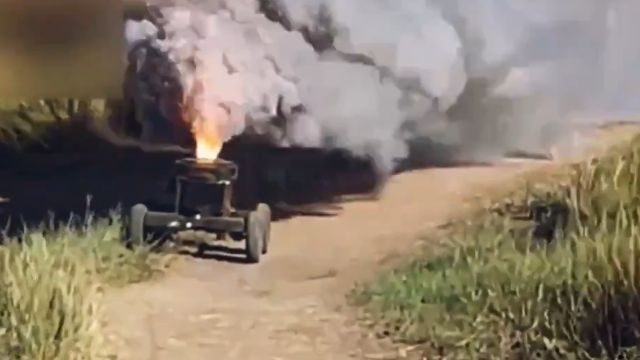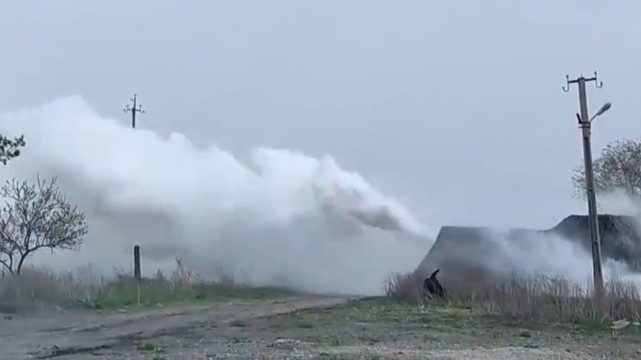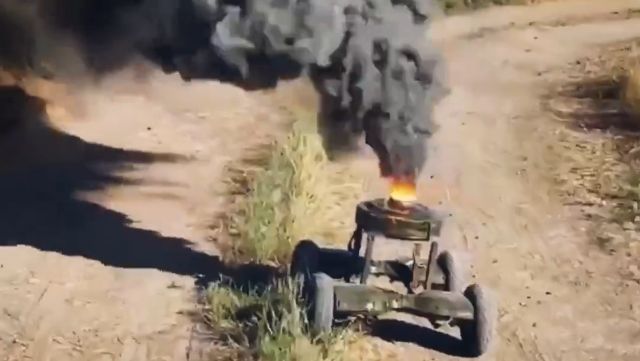In addition to a guided smoke distribution system from land, Russian troops also use an unmanned ground vehicle [UGV] for the same. A video on the Internet shows an easy-to-build or custom-built drone on the ground spreading smoke screens over the battlefield.
The vehicle is simple. The chassis is constructed from crossed metal frames with four rubber wheels. A frame at the top of the chassis mounts the device that disperses the smoke. It closely resembles an anti-tank mine, although this cannot be confirmed. The gas that is activated and burned, apparently from a distance, is very heavy, as observers note.
There is no official information about the operational range of the unmanned ground vehicle. It also doesn’t show the size of the smoke being released. It makes a strong impression that the Russian UGV initially started to produce and spread white thick smoke, which is most common in the battlefield. But just a few seconds later, apparently due to a chemical compound, the smoke became thick, dense and black.
Black smoke
The military often uses a variety of chemical compounds to create smoke screens for concealment and signaling purposes. One of the most commonly used compounds for generating a heavy black smoke screen is hexachloroethane [HC]. Hexachloroethane is a white crystalline solid that produces a thick, dense black smoke when burned. This smoke is very effective at obscuring visibility and can be used to mask troop movements, equipment and other activities from enemy observation.
The black smoke generated by hexachloroethane consists mainly of carbon particles. These particles are effective at absorbing and scattering light, making the smoke extremely opaque and difficult to see through. In addition to hexachloroethane, other compounds such as zinc chloride and aluminum chloride can also be used in smoke-producing mixtures. These compounds can improve the density and persistence of the smoke, making it more effective for military applications.

Although hexachloroethane-based smoke screens are very effective, they also pose certain risks. The combustion of hexachloroethane can produce toxic byproducts, including hydrochloric acid and phosgene gas, which can pose health risks to both deploying forces and the enemy.
TDM-2K
Amid ongoing tensions, smokescreen vehicles have become an important part of the Russian military’s toolbox. In the recent past, numerous TDM-2K vehicles have been deployed along the Ukrainian Contact Line. These specialized military assets are charged with a clear primary responsibility: creating dense smokescreens to conceal the movements of infantry and battle tanks.

A video providing a rare glimpse into these operations was recently released by the Ministry of Defense of the Russian Federation. This video highlights an interview with a tactical unit commander deeply involved in concealing the movements of Russian units. Although his identity remains confidential, he provides a detailed briefing on how his respective unit operates.
According to an anonymous commander, the TDM-2K is praised for its exceptional ability to produce a thousand-meter smokescreen. “It maximizes the survivability of our troops because it protects them from the enemy’s view,” the commander explains. Russian reports indicate that there has been a significant increase in the deployment of TDM-2K on the battlefield since the beginning of this year. This spike may be due to the ongoing ammunition shortage in the Ukrainian armed forces. As a result, the Russian military has increased the frequency of its aerial bombardments and ground advances. In these difficult circumstances, the TDM-2K has emerged as an essential asset for ground forces.
***
Follow us anywhere, anytime. BulgarianMilitary.com has a responsive design and you can open the page from any computer, mobile devices or web browser. For more current news, follow our Google News, YouTube, Reddit, LinkedIn, Tweet and Facebook pages. Our Standards: Manifesto and Ethical Principles.
